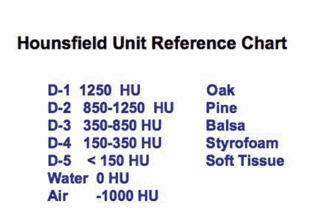

Beam hardening is capable of scattering more radiation and could, therefore, show incorrect Hounsfield units similar to a CT scan: this becomes a limitation for CBCT. Moreover, the most commonly encountered artefact in CT scanning is beam hardening due to the perimeter of an object appearing brighter than the centre. Consequently, CBCT especially includes shorter acquisition times, lower radiation dosages to the patient and submillimetre resolution. However, in cone beam computed tomography (CBCT), the degree of x-ray attenuation is represented by the grayscale (voxel value) and has several advantages over CT. The Hounsfield units are proportional to the degree of x-ray attenuation in the tissue for CT scanning. For example, the evaluation of the fat content of the liver gives a value for the liver-to-spleen ratio in HU <1.0 and liver attenuation <40 HU fat (HU= −120 to −90), cortical bone (HU= +1800 to +1900) white matter (HU= +20 to +30), grey matter (HU= +37 to +45), lung (HU= -700 to −600) and silver foreign objects (HU=+17,000). These HU are reported for an array of clinical applications.
#Hounsfield units ct imagecast software#
Also, the software (3-D slicer or Image J) of all CT scanners and picture archiving and communication systems (PACSs) have the ability to measure the density of a region of interest (ROI) by overlaying the electronic images. Therefore, the HU range from -1000 HU for air to +~2000 HU for very dense bone. Hence, the radiodensity of distilled water at standard temperature and pressure (STP) is 0 HU and the radiodensity of air is -1000 HU. HU are derived from a linear transformation of the measured attenuation coefficients based on arbitrarily assigned densities of air and pure water. Hounsfield units (HU) are used in computed tomography (CT) to represent CT numbers in a standardised format of the resultant image.


 0 kommentar(er)
0 kommentar(er)
